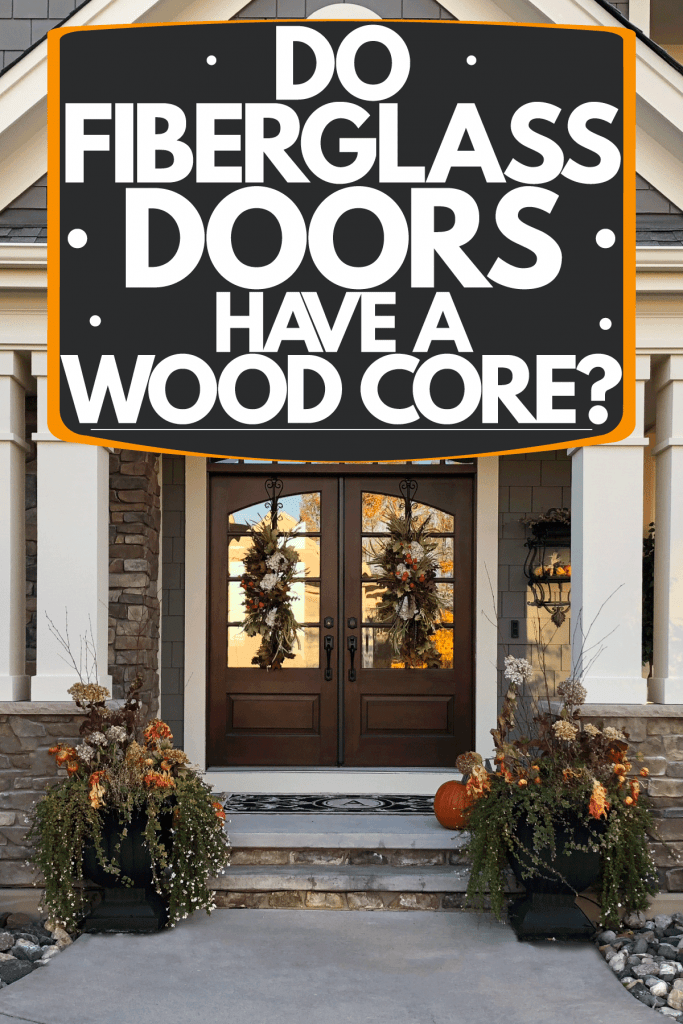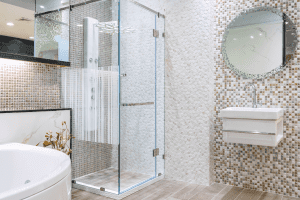Fiberglass doors have steadily grown in popularity over the years. They have even beaten metal doors in a survey about which type of door homeowners would choose as a better wood door alternative mainly due to their durability, low maintenance cost, and almost identical appearance with wood doors. This makes people wonder if fiberglass doors have a wood core. We did the legwork for you to find the answer.
Fiberglass doors do not have a wood core. They are crafted from a variety of natural minerals that range from silica sand, limestone, soda ash, borax, feldspar, and kaolin clay, among others. These components are used to create a core of durable and solid insulation to increase the heat and pressure resistance of fiberglass doors. The wood-like appearance of fiberglass doors is the result of covering the fiberglass slab with a fiber-reinforced polymer and simulated grain.
Fiberglass doors are a great choice for many homes since they have both the properties of wood and steel doors. They can display the stylish and authentic feel of wood doors and provide strong security inherent to steel doors. Scroll through to find out what makes fiberglass doors cut above their counterparts.

Are fiberglass doors solid core?
The simple answer is yes. Even without a wood core, fiberglass doors are solid to the core. They are considered composites because they are molded from various components through a specialized process. These components aren’t strong on their own. But their physical strength and durability far exceed the sum of their parts when combined. This makes fiberglass solid enough to resist the elements, bumps, and strong pressure.
Are fiberglass doors heavy?
It’s noteworthy that even if they are a combination of several components and ingredients, fiberglass doors are still considered lightweight compared to wood.
Are fiberglass doors heat resistant?
In general, fiberglass doors are resistant to heat and non-combustible, especially when made from authentic, high-quality materials.
They can endure temperatures up to 675 degrees Fahrenheit or 357 degrees Celsius, but their tensile strength reduces by half. And when the temperature climbs to 1500 degrees Fahrenheit or 815 degrees Celsius, they start to soften and melt at 2050 degrees Fahrenheit or 1121 degrees Celsius.
This high heat tolerance simply equates to being able to withstand the everyday heat of the sun. So, you can rest easy that fiberglass doors will continue providing you comfort no matter how high the summer heat gets.
Advantages and Disadvantages of Fiberglass Doors

Along with the increasing use of fiberglass doors is the growing variety of styles that matches whatever style you're looking for in your home. Manufacturers even consider easy installation with standard wooden door hardware. If you’re considering a fiberglass door to replace your current door, then you should first learn some of the advantages and disadvantages of its structure.
Advantages
Resistant Against Dents
The manufacturing process of fiberglass doors helps create an impenetrable barrier against impact. As a result, premium fiberglass skin does not dent when hit by sudden or accidental blows, unlike steel and wood doors.
Safe from Moisture
Another positive outcome of the fiberglass door’s composition is its inherent moisture and humidity resistance. Almost, if not all fiberglass doors possess nonporous composite rails and stiles that prevent water from permeating the door. Thus, the tendency for the fiberglass door to rot or warp is non-existent.
Good for Home Insulation
Fiberglass doors have fully insulated cores designed to protect you from extreme cold or heat outside by effectively regulating the temperature inside your home.
The best part? This thermal regulation happens without the expense of extra energy consumption and environmental damage. Fiberglass doors typically have an R-6 rating in terms of R-values, a measurement of an entry door’s thermal resistance. This just means that if you’re using a fiberglass door, you will still be able to save on utility bills even if it’s summer or winter peak.
Low Maintenance Cost
With fiberglass doors, you won't constantly worry about routine upkeep. Their finish only degrades over a long period because their stability ensures that it does not expand or contract, which is a common characteristic of wood doors. Plus, the maintenance work will only require a gel stain and protective varnish to keep the effects of the sun at bay.
Stable for Longer Periods
With natural mineral ingredients, fiberglass doors are much more stable and stronger than wood. They can virtually last for a lifetime and still don’t exhibit signs of shrinking and swelling, which appear in wood doors after 5 to 8 years. Plus, they are safe from termite attacks.
Disadvantages
Challenging Door Sizing and Installation
The durability of fiberglass doors can sometimes work against you and cost you more money and time. Because fiberglass door sizes come in standard options, finding a slab that will fit in your home’s door frame can be difficult. Trimming might be an option. But the strength of the fiberglass can prevent you from doing that.
Customizing the size of the fiberglass slab is your only option for this problem. However, asking the manufacturer to customize the size and mold of the fiberglass slab can cost you a whopping $20,000 to $30,000 or more.
Possibility of the Fiberglass Cracking
Although fiberglass doors do not dent with external pressure, they can still crack when hit by an extremely strong, abrupt force. An example of these instances could be when hit by a hard object, such as a shovel or a golf ball.
How do I know if my door is fiberglass or real wood?
Unlike when they first went public, the modern fiberglass doors today have almost completely mimicked wood doors—thanks to advances in technology. Unless you’re an expert, telling fiberglass doors apart can be difficult. But worry not because we provided you some tips to differentiate authentic wood from fiberglass.
The only method you can employ in distinguishing wood from fiberglass is through superficial inspection of the door.
Color and Texture
A door made of wood possesses the natural color of any wood or tree it was made from. But it can appear darker due to the varnish sometimes. Another indication that will give wood doors away is the smooth feel of the surface in the hands.
On the other hand, a fiberglass door can look exceptionally glossy with a bit of rough texture when touched because of the imprinted texture to mimic wood.
You can also check the door’s bottom and sides. A door made out of wood has small seams on the sides, top, and bottom parts. These are indicative of the different connection points of the various panels used when forming the door. A fiberglass door is only made from a single panel, thus, it does not have these seams.
Sound Check
The last method in checking the doors is by the sound it creates when you knock on them. Solid wood gives a crisp sound when you knock on it, while a fiberglass door may produce a hollow sound, similar to a thud.
If you still can’t tell the two apart despite these methods, you can ask for a professional trained to distinguish the structure and design of the door you want more carefully.
What is the standard door thickness?
You now know that fiberglass is better than wood doors despite not having a wood core. It’s time for you to decide if you’re going with an authentic wood door with high maintenance and low security or a high-quality fiberglass door that is durable, has low upkeep costs and can last for almost half of your life.
Whatever you decide on, there’s still one thing you should consider when choosing a door. And that is its thickness.
The thickness of the door depends on whether it’s for the interior or exterior parts of your home. The standard thickness for an interior door is 1 3/4 inches, according to Rustica, a door manufacturer that focuses on customizing door sizes for their customers. On the other hand, the standard thickness of exterior or front doors can be between 1 3/8 inches to 2 inches. Do note that this thickness can depend on the door material and the height of the door.
Summary
Fiberglass doors are artificially made, but they are still undoubtedly a solid alternative to wood doors. They can provide as many, if not more benefits as their wood counterparts. That's why your doors do not need to be plain wood anymore. Make a statement in your neighborhood that your home is secure and well-insulated with a high-quality fiberglass door.



